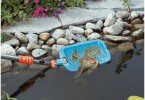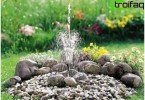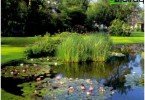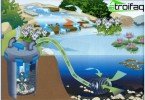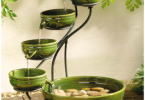What water plants for the pond is better to choose
The creation of an artificial reservoir is a favorite technique in landscape design. The surface of the water diversifies the look, sets up relaxation, satisfies the need for contemplation. However, any water feature will look dull and monotonous if there are no living inhabitants in it. In addition, the creation of a closed biological system will greatly facilitate care, thanks to the natural circulation of substances. Plants for the pond are necessary, and it is important to pick them up, plant them and competently maintain them in a healthy state..
Content
- Classification of Aquatic Flora
- The best plants for the pond
- Pond settlement procedure
- Pond Care
Classification of Aquatic Flora
Aquatic plants are classified according to their growing conditions. Many of their biological features, as well as their role in the ecosystem of the pond, are associated with this indicator. Under deep-water understand plants whose root system is located below 30 cm from the surface of the water. The floating group unites plants that move freely in the water column, receive nutrients directly from it, and do not need to be rooted.
Coastal plants are plants that are submerged no more than 30 cm, the shoots of which, as a rule, are located above the surface of the water, and which form a group that transitions from actually aquatic plants to terrestrial ones. In addition, a special category of oxygen generator plants is distinguished, characterized by an increased ability to saturate water with oxygen.
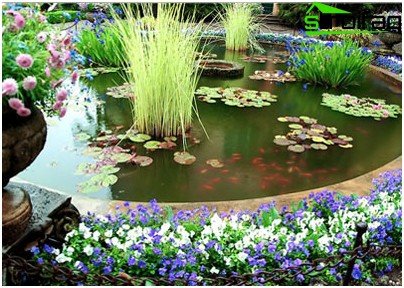
Plants – a natural decoration of the pond
The best plants for the pond
The aquatic and coastal flora of the northern latitudes is not so diverse, and, thanks to this, quite a lot is known about each of the plants of these habitats. Therefore, the creation of live decorations for the pond has a great chance of success. It is convenient to use cold-resistant plants of fresh water, aquarium residents will fall out in the first winter, if you do not put them in a warm room.
Here are a few genera of plants that feel great in northern latitudes:
- Water lily. These luxurious deep-sea plants with large white flowers and round floating leaves, commonly known as lilies, will become a real decoration of any pond. They are planted in containers filled with a mixture of peat and sand, leaving a kidney on the surface and placed in shallow water, as these plants are photophilous. After the appearance on the surface of the leaves, the container is moved to the middle of the reservoir, to a depth of 30-100 cm, depending on the type and variety. Only land when the water warms up to a temperature of at least 8 ° C.
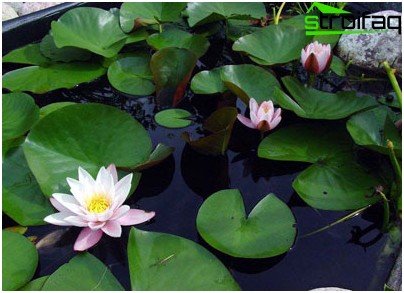
A pair of ordinary water lilies will turn an artificial pond into a masterpiece
- A nice pair of water lilies will be made by a small egg – another ordinary plant of the northern flora with bright yellow flowers.
- Water hyacinth. This floating plant will decorate the pond from June until the first frost, to which it is very sensitive. In winter, the plant must be kept in the aquarium, but these chores are more than paid for by the ability of hyacinth to purify water from organic impurities.
- Exotic lovers can take the azolla floating fern as a plant for a decorative pond. True, for the winter it will also have to be cleaned in a warm room, because this plant comes from tropical America. In addition, azolla grows very quickly, and it will have to be removed regularly, but these surpluses can be used to produce high-quality fertilizer: azolla is extremely rich in nutrients.
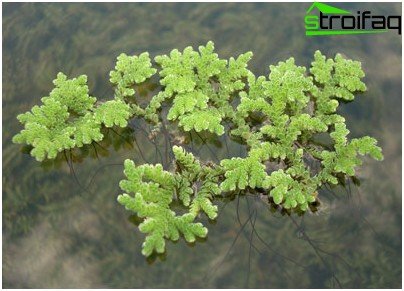
Tropical exotic azolla has long won the love of northern gardeners
- A floating plant of water-color will perfectly complement the beauty of water lilies. Its leaves resemble water lilies in shape, but they are much smaller. And miniature flowers of three white petals and a bright yellow middle appear from June to the end of summer.
- Iris. It is often used in bouquets, but it is also a great plant for an artificial pond. It features a variety of colors – from yellow to purple – and a wide selection of varieties. They grow well on slightly acidic swampy soil, the planting depth should be about 5 cm, but the soil should not be allowed to dry out. Irises tolerate winter well, but it is advisable to cover plants with spruce branches this time of year.
- Another coastal plant that will make an elegant pond in the spring is kaluzhnitsa. In a sunny place, it will delight the owner with numerous large brilliant yellow flowers. Kaluga is propagated by the bush and grows easily, combining perfectly with incense or hosta.
- Speaking of coastal plants, it is impossible not to mention cattail, often called reeds. Its spectacular brown inflorescences adorn the coast until winter, however, in order for the plant to bloom, it is necessary to remove emerging new shoots at the end of summer.
- The most famous oxygenerator is Canadian elodea or water plague. The plant received its second name because of its ability to prompt vegetative propagation, the number of shoots increases very quickly. Therefore, those who dare to contact Elodea do not need to spend a lot of energy on leaving, but at the same time, they will have to regularly remove its excess. In addition, it is undesirable to use elodea for fish ponds, because if damaged, its shoots emit toxic substances for them.
- A much less aggressive oxygen generator is a turkish with graceful dissected leaves and elegant inflorescences of miniature white or pinkish flowers. It is also a floating plant, so caring for it is not at all complicated.
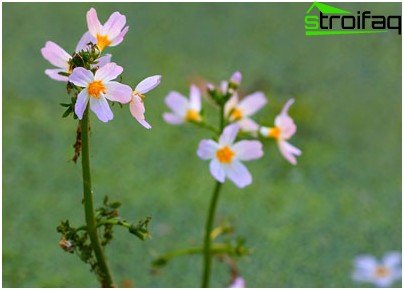
A charming turkish will decorate a pond and saturate it with oxygen
Pond settlement procedure
Plant needs must be taken into account at the planning stage. The smaller the size of the ecosystem, the more difficult it is to maintain its balance, therefore it is desirable that the body of water is at least 4-5 square meters in size and at least half a meter in depth. It is better to avoid open sunflowers, many plants will not like these conditions, and it will be necessary to constantly struggle with the drying up of the coastal zone and the flowering of water.
However, too thick a shadow is also undesirable, it is not suitable for flowering species. The best choice would be a site that is lit by the sun for about 5 hours a day. At the same time, the presence of trees in the vicinity will greatly complicate the maintenance of the reservoir, into which numerous plant debris will constantly fall.
Having planted an aquatic plant in a pot, the soil surface is covered with a layer of gravel about 4 cm thick, preventing blur. You can also purchase special containers designed specifically for underwater landing. Floating leaves of aquatic plants for the pond are very important. They obscure the water, protect it from overheating and prevent the flowering of the water, but it is important not to overdo it: the surface of the water should be covered by plants no more than 1 / 3-2 / 3. There is no need to chase too much species diversity, it is better to limit yourself to 5-7 varieties, it will be easier to maintain the style. First, deep-water plants are planted in the center, then they gradually move to the periphery and end with coastal species..
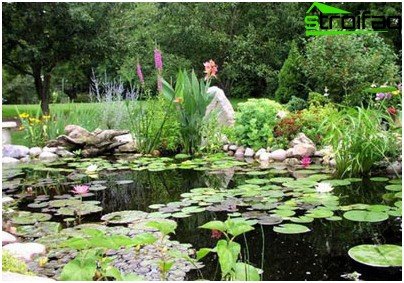
A beautiful pond with different plants will enliven the landscape of a personal plot
Pond Care
It is necessary to remove dead parts of plants in time, for this they use pond scissors, which are conveniently lowered under water and a net, which is easy to catch cut leaves. You also need to remove the debris falling into the pond from the surface with a net: poplar fluff, flowers, birch catkins. With the help of special preparations they regulate the hardness of water, the content of nutrients in it.
Even if it is not planned to settle fish in an artificial pond, it is important to add different animals that are usual for natural reservoirs: snails, water striders, newts, frogs. These inhabitants will eat plant debris in a timely manner and contribute to the balance of the ecosystem. When adding nutrients, it is very important to observe moderation, since their excess will lead to flowering of water – abundant reproduction of blue-green algae. If such a nuisance has occurred, it should be disposed of as soon as possible with the help of special drugs. To prevent this phenomenon, well water should not be added to the pond: in comparison with rainwater, it contains a much larger amount of impurities.
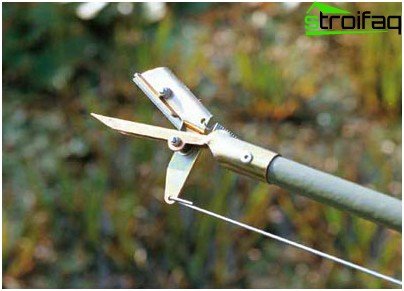
Pond scissors will remove excess parts and not even wet your hands
A small pond on the site is a great place that the whole family will like. This element of landscape design is rapidly gaining popularity, and even a novice gardener can decorate it with plants. Unpretentious and at the same time spectacular plants are easy to find among representatives of the local flora. Transferring several species from the nearest lake and with a minimum of effort, you can create a real masterpiece and pleasantly revitalize the site, giving it naturalness.


